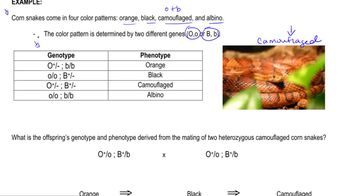- 1. Introduction to Genetics51m
- 2. Mendel's Laws of Inheritance3h 37m
- 3. Extensions to Mendelian Inheritance2h 41m
- 4. Genetic Mapping and Linkage2h 28m
- 5. Genetics of Bacteria and Viruses1h 21m
- 6. Chromosomal Variation1h 48m
- 7. DNA and Chromosome Structure56m
- 8. DNA Replication1h 10m
- 9. Mitosis and Meiosis1h 34m
- 10. Transcription1h 0m
- 11. Translation58m
- 12. Gene Regulation in Prokaryotes1h 19m
- 13. Gene Regulation in Eukaryotes44m
- 14. Genetic Control of Development44m
- 15. Genomes and Genomics1h 50m
- 16. Transposable Elements47m
- 17. Mutation, Repair, and Recombination1h 6m
- 18. Molecular Genetic Tools19m
- 19. Cancer Genetics29m
- 20. Quantitative Genetics1h 26m
- 21. Population Genetics50m
- 22. Evolutionary Genetics29m
Strains of petunias come in four pure-breeding colors: white, blue, red, and purple. White petunias are produced when plants synthesize no flower pigment. Blue petunias and red petunias are produced when plants synthesize blue or red pigment only. Purple petunias are produced in plants that synthesize both red and blue pigment (the mixture of red and blue makes purple). Flower-color pigments are synthesized by gene action in two separate pigment-producing biochemical pathways. Pathway I contains gene A that produces an enzyme to catalyze conversion of a colorless pigment designated to blue pigment. In Pathway II, the enzymatic product of gene B converts the colorless pigment designated to red pigment. The two genes assort independently.

What are the possible genotype(s) for true-breeding blue petunias?
 Verified Solution
Verified Solution



